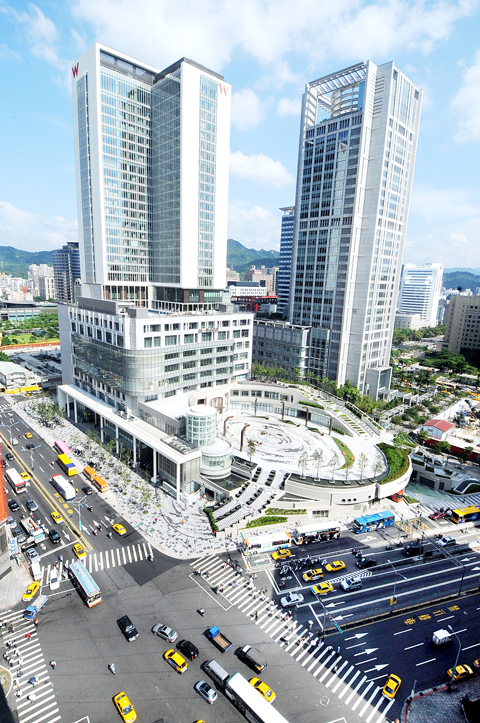Taipei City Hall Bus Station, the major transit hub between Taipei and northern and central Taiwan, opened to the public yesterday, with traffic jams in surrounding areas expected to intensify as a result.
More than 1,700 buses from 14 bus companies will travel daily in and out of the station, which is located at the intersection of Keelung Road and Zhongxiao E Road, and is expected to see about 10,000 people pass through every day between Taipei and Keelung, Yilan, Taoyuan, Hsinchu, Miaoli and Taichung.
Although the Traffic Police Division dispatched more than 140 traffic police to control traffic around the station, Keelung Road and Zhongxiao E Road Sec 5 — which are traditionally crowded during rush hour — still experienced heavier traffic jams.

PHOTO: FANG PIN-CHAO, TAIPEI TIMES
Speaking at the opening ceremony, Taipei Mayor Hau Lung-bin (郝龍斌) called on the public to be patient during the “transition period,” adding that the station was expected to boost businesses in Xinyi District (信義).
“We will use the successful model used at Taipei Bus Station in west Taipei. Taipei City Hall Bus Station, along with the shopping mall above, will bring more people and business opportunities to the Xinyi area,” he said.
The bus station was a build-operate-transfer project under the city government. Its terminals and waiting area occupy about 2,400 ping (7,934m²) of the 43,000 ping building.
The 31-story building, built by Uni-President Group, also features a shopping mall and a hotel.
The Uni-President Hankyu Department Store — a joint venture between Taiwan’s and Japan’s Hankyu Hanshin Department Stores — will open in October.
Democratic Progressive Party Taipei City Councilor Hsu Shu-hua yesterday blamed the traffic congestion on the small space at the bus station and accused the city government of favoring private enterprises by giving up most of the space to contractors for the shopping mall.
“The traffic will only get worse when the shopping mall opens and attracts large crowds,” she said.
Passengers also complained about a lack of seats in the waiting area, urging the city government to improve the situation.
“It’s hard to believe there are only two rows of seats at the bus station. Most people are forced to stand around with their luggage. The city government should not have made such a mistake,” said Huang Ai-ju (黃愛如), a Taipei resident waiting for a bus to Yilan.
Luo Shiaw-shyan (羅孝賢), commissioner of the city’s Department of Transportation, said the waiting area had 77 seats, adding that this was sufficient because most bus routes served short-distance commutes, which required short waiting periods for passengers.
He dismissed concerns that the seating area was purposely designed to be small to provide more room for the shopping areas. He said the department could always add more seats if needed.

Taiwan is to commence mass production of the Tien Kung (天弓, “Sky Bow”) III, IV and V missiles by the second quarter of this year if the legislature approves the government’s NT$1.25 trillion (US$39.78 billion) special defense budget, an official said yesterday. Commenting on condition of anonymity, a defense official with knowledge of the matter said that the advanced systems are expected to provide crucial capabilities against ballistic and cruise missiles for the proposed “T-Dome,” an advanced, multi-layered air defense network. The Tien Kung III is an air defense missile with a maximum interception altitude of 35km. The Tien Kung IV and V

The disruption of 941 flights in and out of Taiwan due to China’s large-scale military exercises was no accident, but rather the result of a “quasi-blockade” used to simulate creating the air and sea routes needed for an amphibious landing, a military expert said. The disruptions occurred on Tuesday and lasted about 10 hours as China conducted live-fire drills in the Taiwan Strait. The Civil Aviation Administration (CAA) said the exercises affected 857 international flights and 84 domestic flights, affecting more than 100,000 travelers. Su Tzu-yun (蘇紫雲), a research fellow at the government-sponsored Institute for National Defense and Security Research, said the air

A strong continental cold air mass is to bring pollutants to Taiwan from tomorrow, the Ministry of Environment said today, as it issued an “orange” air quality alert for most of the country. All of Taiwan except for Hualien and Taitung counties is to be under an “orange” air quality alert tomorrow, indicating air quality that is unhealthy for sensitive groups. In China, areas from Shandong to Shanghai have been enveloped in haze since Saturday, the ministry said in a news release. Yesterday, hourly concentrations of PM2.5 in these areas ranged from 65 to 160 micrograms per cubic meter (mg/m³), and pollutants were

Taiwan lacks effective and cost-efficient armaments to intercept rockets, making the planned “T-Dome” interception system necessary, two experts said on Tuesday. The concerns were raised after China’s military fired two waves of rockets during live-fire drills around Taiwan on Tuesday, part of two-day exercises code-named “Justice Mission 2025.” The first wave involved 17 rockets launched at 9am from Pingtan in China’s Fujian Province, according to Lieutenant General Hsieh Jih-sheng (謝日升) of the Office of the Deputy Chief of the General Staff for Intelligence at the Ministry of National Defense. Those rockets landed 70 nautical miles (129.6km) northeast of Keelung without flying over Taiwan,